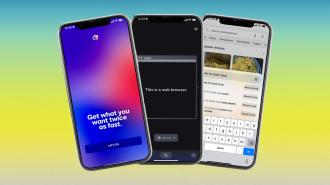It’s hard to remember a time when Google wasn’t the dominant player in the search industry. Depending on whose numbers you use, as of December 2023, Google accounts for over 90% of the global search market. However, the tech giant’s search market dominance hasn’t prevented competitors from innovating with new search experiences powered by AI.
One new player is The Browser Company, a startup founded by Josh Miller and Hursh Agrawal in 2019. The Browser Company’s main product is Arc, a Chromium-based browser built on the open-source product that underpins Google Chrome. On January 28, 2024, the company released Arc Search on iOS, an AI-powered search app that does the searching for you and builds a custom website based on your results.
Search > chatbot: The potential for AI technologies, like LLMs, to disrupt the search industry became obvious once OpenAI’s ChatGPT amassed over 1 million users within its first week of release. At that time, the chatbot could not access the web, so its responses were limited to the information in its dataset. It was and still is prone to “hallucinations” (aka, confidently making things up). But the potential for an AI to assist a user by answering their questions directly was clear, and for the most part, it worked amazingly well.
Since then, not only is ChatGPT able to search the web, but so too are LLMs from ChatGPT’s competitors such as Claude, Bard, Copilot, and Perplexity. However, as a user, I find the chat-based interface is not always ideal for searching, particularly on mobile. The chatbot interface can just be cumbersome. And that’s what makes Arc Search a potential game changer. The interface is slick and intuitive.
What you get: The marquee feature of Arc Search is the AI-powered “browse for me” that uses OpenAI’s API to create a webpage that summarizes all the useful results of the search. After you enter a question into Arc Search and hit “browse for me,” swiping becomes the primary means for navigating your results. Arc Search’s results are broken into different sections. At the top, you’ll get an image carousel to swipe through to view various image results. Each image is clickable, taking you to the web page corresponding to each image. A swipe left will return you to your results page.
Below the image carousel is a high-level breakdown that (generally) answers the question you’ve asked Arc to answer. Below that is a summary of your query’s top three search results. A more specific breakdown of your results follows the top search results.
The bottom of each Arc Search web page includes a “deeper dive” section that lists more links to browse if the summarized results don’t fully answer your question.
The killer app: My favorite use, thus far, has been finding simple recipes. Getting a recipe through traditional search has become a chore — mind-numbing scrolling through endless text and ad spam until you find a recipe you want to use is simply not a fun user experience. With “browse for me,” when I want to remind myself of simple steps or ingredients, Arc Search highlights multiple recipe options and their ingredients in the customized website, allowing for much faster browsing of options while shopping, prepping ingredients, or actually cooking.
“Browse for me” isn’t the only way to search in Arc Search; it is possible to utilize traditional search options like Google on the app, but the functionality and speed of the AI feature is one of its biggest draws, at least initially. This is supported by Josh Miller, the CEO of The Browser Company, posting on X that the “browse for me” functionality in Arc Search accounts for a higher-than-expected percentage of all search queries on the app.
The bottom line: As a user, the Arc experience can be summarized pretty simply: it’s enjoyable. The app is incredibly responsive and fast, and navigating the “browse for me” websites is simple. Searching within the results is quickly done with one hand, which is fantastic for mobile.
In his review of Arc Search for Mac Stories, Federico Viticci noted some features are missing from the initial launch of the app that could make it difficult for some users to use it as their primary mobile browser:
“…there are no Shortcuts actions or widgets for Arc Search; there is no equivalent to Safari’s excellent ‘Paste and Go’ and ‘Paste and Search’ address bar actions; you cannot rename your favorites or sort them into folders; there is no built-in reading list; you can’t download files; 1Password auto-fill sometimes doesn’t work. If you get a lot of work done on your iPhone using Safari and if that work includes relying on extensions (which Arc doesn’t support) or features shared across platforms (such as tab groups, profiles, or shortcuts), it’d be hard to recommend Arc Search right now.”
But even with those shortcomings, Federico has decided to make Arc Search his primary mobile browser. The reason why is simple: “It’s the distillation of what I want from a mobile browser.” I wholeheartedly agree.
We’d love to hear from you! If you have a comment about this article or if you have a tip for a future Freethink story, please email us at [email protected].






